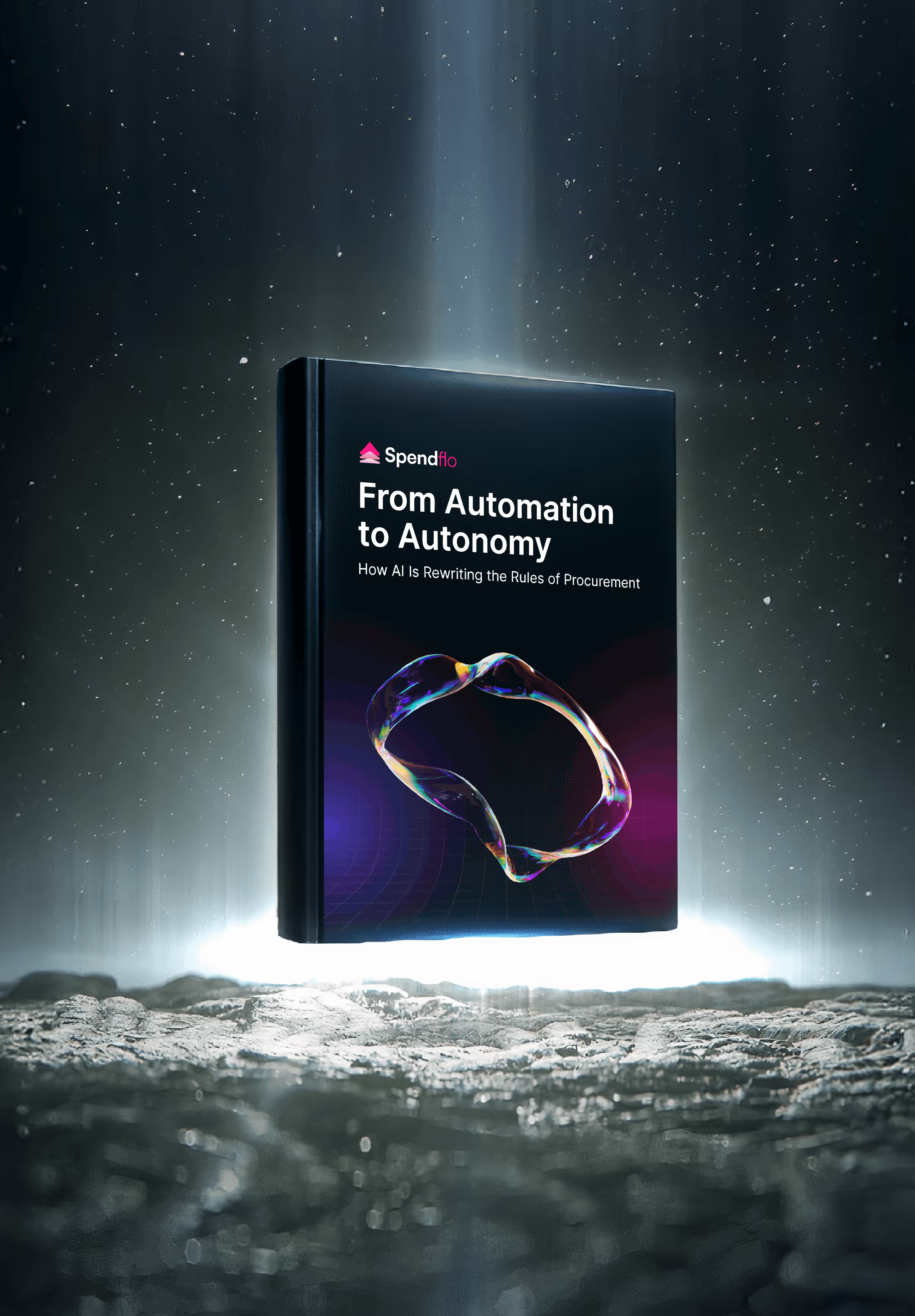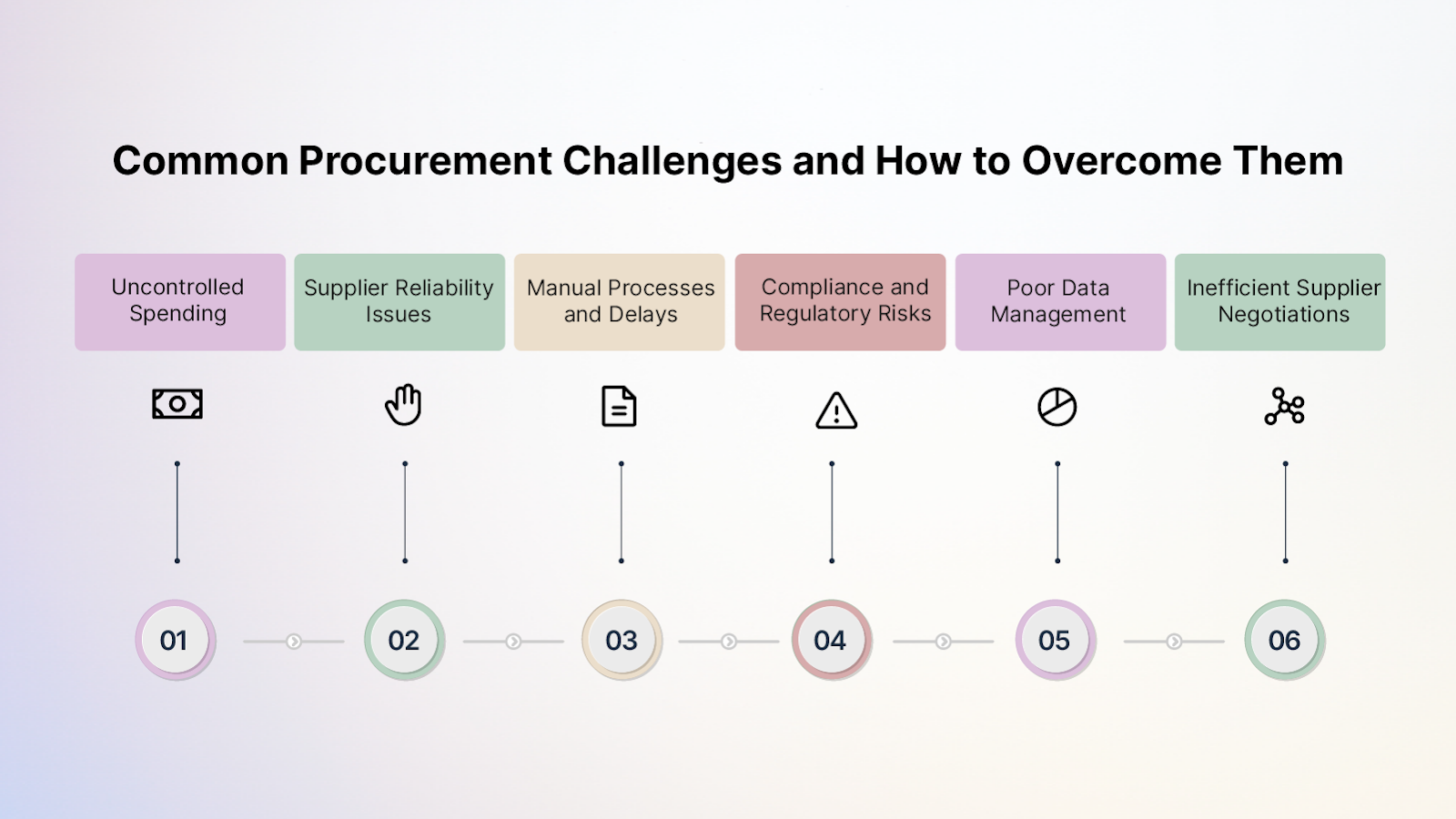

12 Procurement Best Practices to Streamline Processes in 2025

12 Procurement Best Practices to Streamline Processes in 2025
Learn 10 procurement best practices to optimize spending, improve supplier relationships, and enhance efficiency. Implement strategies to reduce costs.


According to Deloitte, procurement inefficiencies can cost companies nearly 15% of their annual revenue. Yet many teams still depend on spreadsheets, emails, and manual approvals to manage vendors and purchases. These gaps don’t just slow things down, they drive overspending, compliance issues, and supply chain risks that hit profitability hard.
It’s why procurement transformation has become a top priority for finance and operations leaders. By adopting modern procurement practices, businesses can cut waste, build stronger supplier relationships, and run operations more efficiently.
What is Procurement?
Procurement is the process of sourcing and purchasing goods or services a business needs to operate. It includes selecting suppliers, negotiating contracts, and managing costs to ensure efficiency, compliance, and savings, helping organizations boost profitability and reduce risks.
Top 12 Procurement Best Practices
Procurement inefficiencies can cost businesses up to 15% of their annual revenue, yet many still rely on manual workflows and outdated systems. A strong procurement framework isn’t just about cost-cutting, it’s about creating value through better visibility, supplier collaboration, and smarter decision-making.
Here’s a detailed look at the top 10 procurement best practices to optimize costs, improve relationships, and future-proof your operations.
1. Develop a Strategic Procurement Plan
What: A strategic procurement plan aligns purchasing goals with business objectives. It outlines supplier selection criteria, approval workflows, and budget allocation, serving as a procurement transformation roadmap for every purchase decision.
Why: Without a clear plan, organizations often overspend or face bottlenecks due to unclear roles and fragmented data. A structured plan improves efficiency and helps teams stay aligned on priorities.
How:
- Audit your current procurement processes and identify inefficiencies.
- Define procurement objectives that align with organizational goals.
- Set measurable KPIs for supplier performance and spending.
- Use spend analytics to track trends and budget utilization.
- Review and refine your plan quarterly to stay aligned with market shifts.
2. Establish Strong Supplier Relationships
What: Building solid, long-term partnerships with suppliers ensures reliability, better pricing, and mutual growth.
Why: Vendors who understand your business are more likely to offer flexibility, share innovation ideas, and support you during disruptions.
How:
- Schedule quarterly reviews with key suppliers.
- Maintain open communication channels for feedback and issue resolution.
- Develop joint improvement plans with strategic vendors.
- Use a vendor management system to track interactions and contract renewals.
- Diversify your supplier base to reduce dependency risks.
3. Leverage Technology and Automation
What: Automation reduces manual work and centralizes procurement activities like approvals, invoicing, and contract management.
Why: Digital procurement tools help eliminate repetitive tasks and improve accuracy, freeing your team to focus on high-value strategic work.
How:
- Deploy a centralized procurement platform for unified visibility.
- Automate purchase requisitions and approval workflows.
- Integrate procurement tools with ERP systems to ensure data consistency.
- Use AI-driven analytics for spend forecasting and performance reporting.
- Regularly audit automation rules to ensure compliance.
4. Implement Spend Visibility and Cost Control
What: Spend visibility means tracking every dollar spent across categories and departments.
Why: Without visibility, organizations risk budget overruns, duplicate purchases, and missed savings opportunities.
How:
- Consolidate spend data across all systems.
- Establish budget thresholds and category-specific approval levels.
- Use dashboards for real-time insights and anomaly detection.
- Conduct monthly spend reviews to track performance.
- Align spending patterns with strategic business goals.
5. Ensure Procurement Compliance and Risk Management
What: Procurement compliance ensures that all purchases follow regulations, company policies, and ethical standards. Risk management focuses on identifying potential disruptions before they occur.
Why: Non-compliance can lead to financial penalties and reputational harm. Managing risks proactively keeps the supply chain resilient.
How:
- Draft a comprehensive procurement policy.
- Perform supplier due diligence before onboarding.
- Use automation to flag non-compliant purchases.
- Conduct regular compliance training for teams.
- Review policies annually to keep up with regulatory updates.
6. Adopt Sustainable and Ethical Procurement
What: Sustainable procurement integrates environmental and social responsibility into purchasing decisions.
Why: Customers and investors increasingly expect businesses to operate responsibly. Ethical sourcing enhances credibility and long-term value creation.
How:
- Work with suppliers who prioritize eco-friendly materials and ethical labor.
- Include sustainability criteria in RFPs and supplier evaluations.
- Monitor and report sustainability metrics.
- Offer training on ethical procurement standards.
- Recognize suppliers who demonstrate measurable improvement.
7. Expand Vendor Diversity and Support Local Economic Development
What: Inclusive sourcing means partnering with suppliers from varied backgrounds, including minority-owned, women-owned, and small local businesses.
Why: Encouraging vendor diversity not only meets ESG and inclusion goals but also strengthens community ties and reduces supply chain risks.
How:
- Source from minority-owned supplier procurement networks and local businesses.
- Implement a supplier diversity program with measurable targets.
- Collaborate with regional chambers or development agencies for outreach.
- Track and report on vendor diversity best practices across departments.
- Support initiatives that boost local economic development procurement.
8. Focus on Total Value, Not Just Lowest Price
What: Value-based procurement prioritizes total cost of ownership (TCO) over the lowest upfront price.
Why: Low-cost suppliers can result in poor quality, delays, or compliance failures, creating false savings. Considering TCO ensures sustainable value over time.
How:
- Evaluate suppliers on quality, reliability, and service, not just price.
- Calculate TCO procurement including maintenance, logistics, and warranty costs.
- Factor in innovation and sustainability in decision-making.
- Build long-term partnerships that deliver consistent value.
9. Modernize and Digitize Procurement with eProcurement
What: eProcurement best practices use technology to manage sourcing, bidding, contracts, and communication digitally.
Why: Digital transformation improves transparency, speeds up approvals, and ensures audit-readiness.
How:
- Adopt an eProcurement platform for end-to-end workflows.
- Digitize procurement processes like RFPs, bidding, and invoicing.
- Use dashboards for real-time visibility and control.
- Implement tools that support procurement digitalization 2025 standards.
- Regularly review data accuracy to ensure reliable reporting.
10. Invest in Procurement Talent and Succession Planning
What: Procurement success depends on skilled professionals and leadership continuity.
Why: Developing talent ensures the organization can sustain innovation and adaptability as the procurement landscape evolves.
How:
- Hire professionals with data and negotiation skills.
- Offer ongoing procurement certification programs and upskilling.
- Build succession planning procurement strategies for leadership roles.
- Create mentoring and CPO leadership training opportunities.
- Recognize and retain high-performing procurement talent.
11. Maintain a Clean and Updated Vendor Master File
What: A clean vendor master file ensures accurate supplier data and reduces financial errors.
Why: Duplicate or outdated records can cause delays and compliance risks. Maintaining data hygiene improves reporting and decision-making.
How:
- Regularly remove duplicate and inactive vendors.
- Standardize formats for vendor names, addresses, and tax IDs.
- Use AI tools for vendor data cleanup and validation.
- Establish controls for supplier master data management and accuracy.
12. Leverage AI for Smarter Procurement Decisions
What: AI is transforming procurement by automating analysis, predicting spend patterns, and managing risks.
Why: AI helps teams make faster, data-driven decisions and eliminate manual errors.
How:
- Use AI procurement tools for spend analytics and forecasting.
- Apply predictive procurement analytics to anticipate market shifts.
- Automate AI supplier risk monitoring to flag issues early.
- Implement chatbots to assist employees with procurement queries.
Common Challenges In Implementing Procurement Best Practices & How To Overcome Them?
Procurement plays a crucial role in business success, but it comes with its share of challenges. Inefficient processes, unexpected costs, and supply chain disruptions can impact business operations.
Here are some common procurement challenges and how to address them effectively:

Uncontrolled Spending
Without proper visibility, organizations often experience maverick spending. Implement procurement guidelines, approval workflows, and spend-tracking tools to maintain budget control.
Supplier Reliability Issues
Late deliveries or inconsistent quality can disrupt operations. Establish long-term relationships, conduct supplier audits, and diversify vendors to reduce dependency.
Manual Processes and Delays
Relying on spreadsheets and emails slows down procurement. Use procurement automation software to streamline workflows and reduce processing time.
Compliance and Regulatory Risks
Non-compliance can result in legal and financial penalties. Regularly review procurement policies, conduct compliance audits, and use contract management tools.
Poor Data Management
Fragmented data makes it difficult to analyze procurement trends. Centralize procurement data with analytics tools to track performance and spending patterns.
Inefficient Supplier Negotiations
Without proper market insights, businesses may overpay. Leverage benchmarking data, negotiation strategies, and contract lifecycle management tools to secure the best deals.
Addressing these challenges ensures procurement remains efficient, cost-effective, and aligned with business goals.
Benefits of Implementing Procurement Best Practices
Implementing procurement best practices enhances cost savings, streamlined operations, and strengthens supplier relationships. These practices help businesses reduce financial risks, improve efficiency, and drive long-term success in supply chain management.
Here are the key benefits of adopting procurement best practices:

Cost Savings and Spend Optimization
Procurement best practices enable businesses to negotiate better contracts, secure volume discounts, and avoid unnecessary expenditures. By improving supplier management and using data-driven insights, companies can cut costs without compromising quality or service levels.
Improved Supplier Relationships
Strong supplier partnerships lead to better pricing, priority service, reduced risks. A structured procurement process fosters transparency, accountability, and trust, ensuring suppliers deliver on time and meet quality standards.
Risk Mitigation and Compliance
Procurement processes ensure regulatory compliance with industry regulations, reducing legal risks and financial risks. Standardized procurement workflows help identify supplier risks early, protecting businesses from supply chain disruptions and regulatory penalties.
Enhanced Operational Efficiency
Automating procurement workflows minimizes manual errors, speeds up approvals, and reduces administrative burdens. A well-defined procurement strategy streamlines purchasing, saving time and improving internal coordination across departments.
Better Data-Driven Decision Making
With structured procurement, businesses gain access to spending trends, supplier performance, cost efficiencies. This insight enables organizations to optimize budgets, predict future costs, and make more informed financial decisions.
Sustainable and Ethical Procurement
Implementing ethical sourcing and sustainability initiatives helps businesses align with corporate social responsibility (CSR) goals. Sustainable procurement ensures compliance with environmental and labor regulations, improving brand reputation and customer trust.
A well-executed procurement strategy strengthens financial stability, reduces risk, and improves efficiency. By following best practices, businesses can optimize procurement processes and a competitive edge in the market.
Procurement Metrics and KPIs That Matter
Tracking the right procurement metrics ensures efficiency, cost control, and supplier performance. Businesses that monitor key KPIs can optimize spending and streamline procurement workflows.
Here are six essential procurement metrics to track:
Cost Savings Percentage
Measures reductions in procurement costs through negotiations, vendor consolidation, and process improvements. It helps assess overall procurement efficiency.
Procurement Cycle Time
Tracks how long it takes to complete a purchase from requisition to payment. Shorter cycle times indicate a more efficient procurement process.
Supplier Performance Score
Evaluates vendors based on quality, reliability, delivery times, and pricing. Helps identify top-performing suppliers and areas for improvement.
Contract Compliance Rate
Ensures that purchases align with agreed-upon contracts. High compliance rates indicate better vendor management and fewer cost overruns.
Maverick Spending Rate
Measures unauthorized or unapproved purchases outside the procurement process. A lower rate signals better control over procurement policies.
Procurement ROI
Compares procurement investments (technology, personnel, and process improvements) with cost savings and efficiency gains to measure overall procurement success.
By focusing on these KPIs, businesses can improve efficiency, reduce costs, and enhance supplier relationships.
Future Trends in Procurement
Procurement is evolving rapidly, driven by technology, sustainability, and data-driven decision-making. Businesses that adapt to these trends can gain a competitive edge and improve efficiency.
Here are six key trends shaping the future of procurement:
AI and Automation
Artificial intelligence is transforming procurement with predictive analytics, automated approvals, and smart contract management. This reduces manual effort and enhances decision-making.
Blockchain for Transparency
Blockchain technology in procurement is improving supply chain visibility by providing secure, tamper-proof transaction records. It helps verify supplier credentials and ensures compliance.
Sustainable Procurement
More businesses are prioritizing ethical sourcing and environmentally friendly practices. Procurement teams are focusing on carbon-neutral suppliers and waste reduction strategies.
Data-Driven Decision Making
Advanced analytics are helping companies optimize procurement costs, forecast demand, and assess supplier performance with real-time insights.
Supplier Risk Management
Companies are investing in risk assessment tools to monitor supplier financial stability, compliance, and geopolitical risks. Proactive risk management ensures supply chain resilience.
Cloud-Based Procurement Platforms
Cloud solutions are enabling remote procurement management, collaboration, and integration with other enterprise systems. This enhances agility and scalability in procurement.
By embracing these trends, organizations can future-proof procurement strategies and stay ahead in a rapidly changing market.
Conclusion
Procurement inefficiencies can quietly drain millions every year, from missed renewals to manual approval delays that slow the entire purchasing cycle. When one of Spendflo’s clients, a fast-growing SaaS company, centralized procurement with Spendflo, they cut costs by 30% in the first year and gained complete visibility into vendor contracts and renewals.
Many organizations still face the same challenges: disconnected systems, limited spend visibility, and slow decision-making that limits savings potential. That’s where Spendflo changes the game. Our AI-powered procurement platform simplifies buying, automates workflows, and gives finance and procurement teams the clarity they need to make smarter, faster decisions.
Ready to take control of your procurement spend and see guaranteed savings? Book a demo with Spendflo today.
Frequently Asked Questions (FAQs) on Procurement Best Practices
What are the key benefits of adopting procurement best practices?
Procurement best practices help businesses reduce costs, improve supplier relationships, enhance compliance, and streamline purchasing workflows. They also provide better spend visibility and mitigate risks, leading to more efficient and strategic procurement decisions.
How can automation improve procurement efficiency?
Automation eliminates manual errors, speeds up approvals, and provides real-time data insights for better decision-making. Tools like procurement software streamline purchase orders, supplier management, and contract negotiations. This makes the entire process faster and more transparent.
What factors should be considered when selecting suppliers?
Key factors include cost, quality, reliability, compliance, scalability. Businesses should evaluate supplier performance, financial stability, and risk factors to ensure long-term value and avoid disruptions.
How does procurement help with cost control?
Procurement best practices include spend analysis, strategic sourcing, contract management, and supplier negotiations to optimize costs. Implementing spend visibility tools ensures that businesses track and manage expenses effectively.
What challenges do organizations face in implementing procurement best practices?
Common challenges include maverick spending, supplier risks, manual inefficiencies, compliance issues, and lack of procurement visibility. Overcoming these requires automation, data-driven decision-making, and structured procurement policies.










.png)




.png)










.avif)





